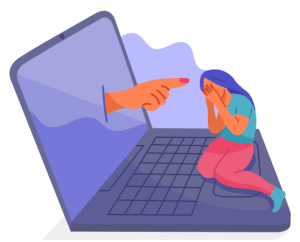
Virtual sexual harassment
What’s wrong with sending kiss emojis to a female colleague in a professional whatsapp group?”
“What’s wrong with wearing a vest for a work meeting?”
“What’s wrong with asking someone to keep their video on during a meeting?”
What’s wrong with calling someone in the night to discuss work?”
These have been some questions that have been asked in the training sessions that I have conducted post March 2020.
2020 changed our lives permanently. Overnight, we went from working from the office to working from home. It changed our work routine and working hours got blurred.
Work meetings, conferences, coffee breaks and even Friday night parties – all shifted online. In the process, we got introduced to each other’s family, cats, dogs, plants and everything in between. Our intimate private spaces became public spaces.
While WFH did increased our working hours and added anxiety and fear due to dwindling economy, it did bring a false sense of hope that at least incidents of workplace sexual harassment will decrease. Many of us who work in this domain also felt the same.
But this hope was short-lived. Few months into the lockdown and we started seeing many newer and subtle examples of sexual harassment in the workplace. Examples such as forcing employees (especially female employees) to switch their video cameras and/or asking them to adjust their cameras, or video calls at odd hours, coming to the meeting drunk, forcing female employees to engage in conversation and sharing details about intimate sexual life, making sexual comments and innuendos, stalking and repeatedly commenting on social media, coming to meetings wearing vests and in some cases, even shirtless, wearing shirts with inappropriate pictures/phrases, commenting about someone personal life, et cetera, all constitute instances of sexual harassment.
According to the National Commission for Women (NCW) reported cases of online sexual harassment of women at the workplace have increased by five times since the outbreak. However, during the same time, the number of complaints decreased and there were many reasons for the same. Many of them were not sure whether virtual sexual harassment falls under the scope of the Act and even if they come forward with the complaint, many didn’t know how to prove the allegations since they did not have any evidence. Fear of retaliation and increasing job losses also added to the fear and many chose to remain quiet and in some cases, dropped out of the workplace.
As employers, it is important to understand that POSH Act also includes virtual sexual harassment and that it is applicable even in a WFH scenario. The Sexual Harassment of Women at Workplace (Prevention, Prohibition and Redressal) Act & Rules, 2013 defines sexual harassment as any unwelcome physical, verbal, or non-verbal conduct of sexual nature. In other words, sexual harassment need not be physical. Therefore, any incident that takes place in a virtual world will fall under the scope of sexual harassment.
Further, the law also states that a workplace is, “any place visited by the employee arising out of or during the course of employment”. Since due to lockdown, people are currently working from home, home is technically a workplace and therefore, falls under the definition. Remote working is here to stay and with many organisations shifting to remote working for a foreseeable future, it is important for organisations to create work environments that are safe and inclusive. A starting point is to communicate to all employees about the POSH Act, which includes discussion on virtual sexual harassment in the context of WFH scenarios as well.
It is equally important to train them to identify ways in which online harassment can take place as well as inform them about the redressal mechanism, in case anyone wants to report it. Internal Committee training needs to include ways in which inquiries can take place virtually, while manager training needs to also include ways to safeguard their teams as well as the organisation in a virtual set up. Organisations also need to re-look at their existing POSH policies and amend them to make room for WFH scenarios.
Creating a safe place, whether it is office or home, is not only important from the overall health of the organisation, but also because there is also an economic cost of sexual harassment. In India, many organisations[1] have been slapped with hefty fines for non-compliance with the law. In a study by the Australian Human Rights Commission, it was found that in 2018, workplace sexual harassment cost $2.6 billion in lost productivity and $0.9 billion in other financial costs.
In a nutshell, work from home is here to stay and so is virtual sexual harassment. Therefore, it is imperative that employers wake up to this reality and start redefining workplace rules and policies to ensure that their zero-tolerance policy is followed both in letter and in spirit.
Want to know more about the Author, click here
